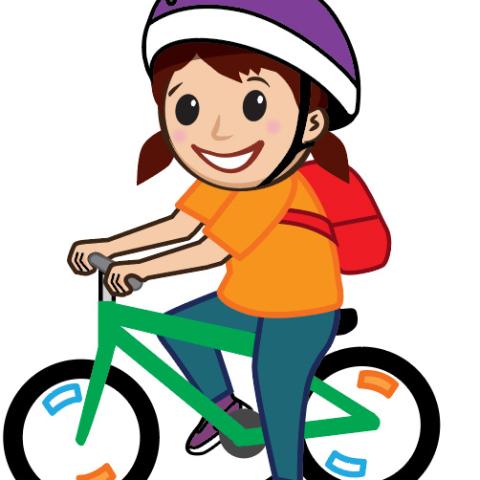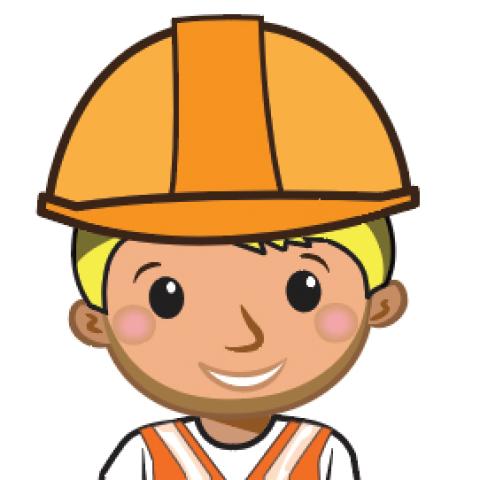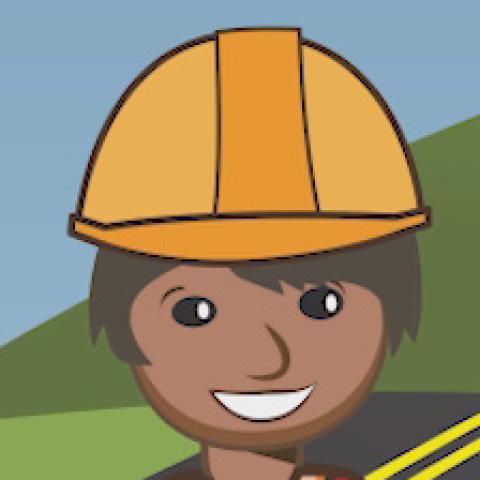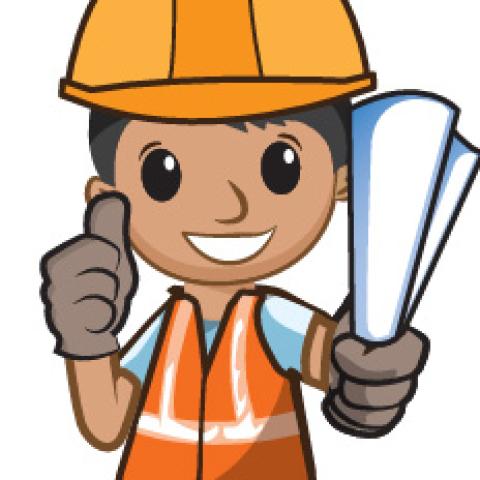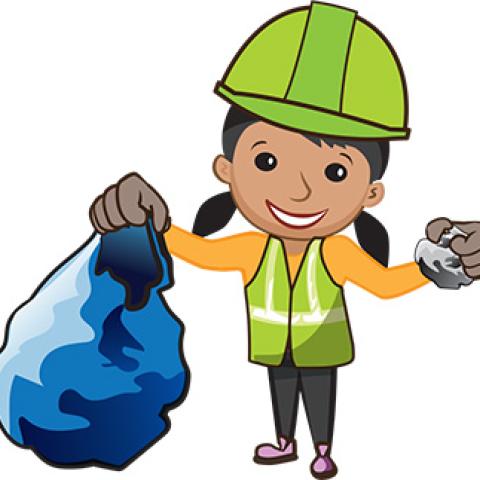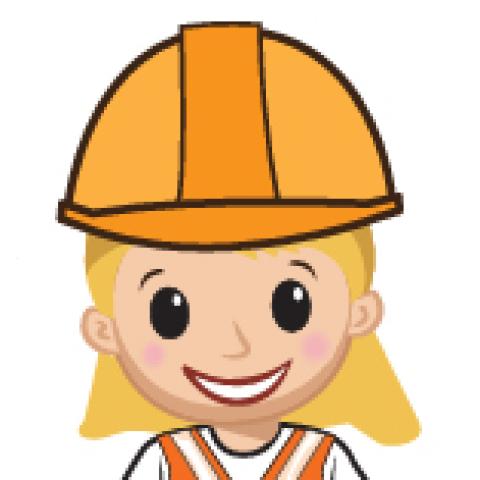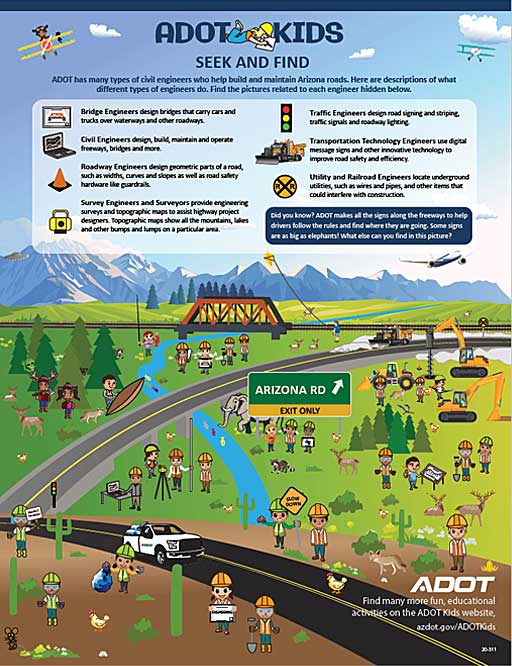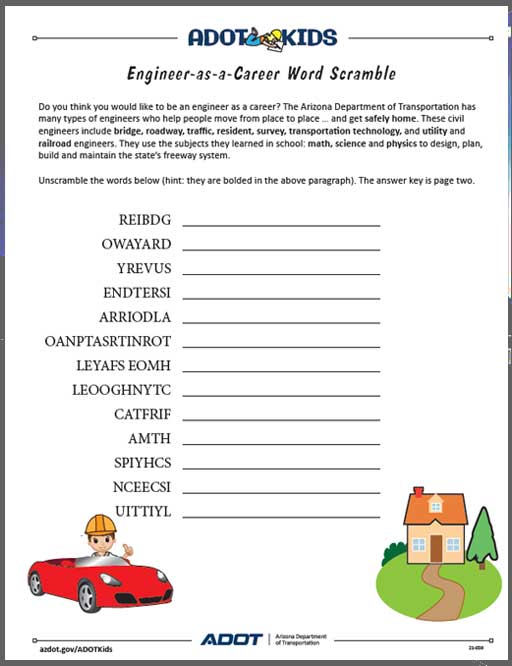#ADOTKids
ADOT Kids - Engineer as a Career
ADOT Kids - Engineer as a Career
Types of Engineers
Bridge engineers design the bridges that carry cars and trucks over waterways and other roadways.
Roadway Engineers design the geometric parts of a road such as widths, curves and slopes. They also design road safety hardware like guardrails.
Traffic Engineers design road signing and striping, traffic signals and roadway lighting. They also design traffic control plans used to help traffic move safely through a work zone.
Roadway, Bridge and Traffic engineers also use mathematics and science to determine where or how to build new highways and to make existing highways better. Roadway engineers work with many other types of engineers and together they make plans for construction to make the highways. Bridge engineers use computer programs to design bridges that are used to allow roadways to cross other roadways, rivers, washes and railroads. Traffic engineers design the signs and pavement markings that help make the highways safe to drive on and help people understand where they need to go.
If you’ve got the inclination to draw, design, problem solve and create order, think about a career as a civil engineer, who uses computer-aided design and drafting. You'll learn to prepare the kind of technical drawings used to build freeways, bridges, and more! Civil engineering deals with the design, construction, and maintenance of the physical and naturally built environment. This includes public works such as roads, bridges, canals, dams, airports, sewerage systems, pipelines as wells as structural components of buildings and railways.
There are many sub-disciplines within the broad field of civil engineering and ADOT has many of them, such as roadway engineers, traffic engineers and bridge engineers. They apply technical design processes to prepare detailed construction plans for transportation infrastructure. Other sub-disciplines include geotechnical engineers, whose knowledge of soils and rocks are important to building roads and bridges; Drainage engineers with expertise in designing for flooding and erosion control; and environmental engineers with expertise in minimizing the negative impacts to the environment while constructing and maintaining transportation features.
Resident Engineers work in ADOT district offices and they make sure that contractors who build the projects follow the design plans. They also help resolve challenges and find solutions while the project is being constructed.
Before a designer can prepare construction plans for highways, roads and bridges, they need more information about the land they wish to build on. Survey Engineers and Surveyors provide engineering surveys and topographic maps to assist designers of ADOT highway projects. (Topographic maps show all the mountains, lakes and other bumps and lumps on a particular area.) They collect and analyze 3-D information about the land, roads, and bridges. They use sophisticated equipment such as Global Positioning Systems (GPS), aerial drones, electronic theodolites and levels. They then use computers to make 3-D digital drawIngs for design engineers to use while designing highways. Survey engineers and surveyors also help ADOT’s Right of Way group by performing property surveys.
Did you know that George Washington was a surveyor? Surveyors use tools to measure and locate features like mountains and rivers on the land that can be used to make topographic maps. Topographic maps are of the “topography” which shows the surface of the earth and its features like hills, rivers and houses on the land. These maps and plans help engineers design highways and bridges. Aerial photography is done by planes or drones taking pictures from the sky.
Transportation technology engineers use computers, electronics, control systems (like traffic lights), communications technologies and management strategies for transportation systems to provide travel information to improve road safety and efficiency. As new transportation technologies emerge like self-driving vehicles and smart/connected cars, transportation technology engineers ensure that our infrastructure safely accommodates these emerging transportation trends.
Have you seen the message boards along the freeway? These are types of transportation technology. Technology is also used to calculate the travel times that they show on the boards like how long it will take to get from Phoenix to Tucson based on distance and how fast cars can travel. For example, if there is a crash on a road and there is a lane closed the time it takes to get to Tucson from Phoenix will be much longer.
Have you ever started digging a hole and found something you didn't expect? ADOT’s utility and railroad engineers work with utility companies and design engineers to locate underground utilities (like pipes and cables that transport water, gas and electricity to buildings), and other items that could interfere with construction. They use non-invasive technology and techniques along with carefully controlled excavation methods to provide detailed information on underground features so they can either be avoided or relocated. This process is important to construction workers’ safety, maintaining utility service continuity to customers and controlling construction costs. This group also makes sure that railroad crossings at state highways are safely designed.
Superman may be stronger than a locomotive, but the rest of us are not. To ensure that trains and cars can travel safely while sometimes crossing paths, utility and railroad engineers ensure the safety of motorists and train operators by using signs, signals and pavement markings.
Did you know that things like the water and electricity that come into your house are called “utilities?” The pipes that bring the water and the wires that bring the electricity are located in pipes underground or wires that are strung from large poles. Utility engineers help place all these pipes and wires under the ground or on poles. ADOT does not have engineers that drive trains but they have engineers to determine what to do when a road and a railroad meet at a railroad crossing or when a bridge goes over or under a railroad.
Activities
Articles
Hey, ADOT Kids! Try our word scramble, learn some interesting facts about license plates!
Here’s a little history: When the automobile was invented, there were so few of them that license plates were not necessary. As cars started to outnumber the horse and buggy, many states began to require license plates to identify the car and owner.
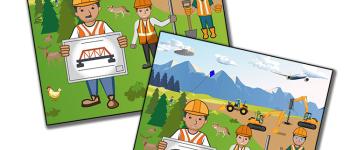
ADOT Kids: Test your skills of observation and learn how ADOT builds a freeway
As with any important project (think writing a report for school), the first thing to do is plan. ADOT starts planning for new roadways by studying where a new roadway is most needed.
Next, ADOT engineers begin to create the detailed project plan. Some roads need bridges or overpasses as part of their design. Can you think why a bridge or overpass might be needed?

ADOT Kids: I spy … a red bird, coyote, snake ... “BINGO!”
Hey ADOT Kids (and parents)!

Hey ADOT Kids! Do you love a good rainstorm?
As an Arizona kid, you are likely used to many days of hot, dry weather. When we get the occasional rainstorm, do you celebrate by dancing in the rain (but never during a thunderstorm), rather than heading indoors to stay dry?
You may have learned about the earth’s water cycle and how water moves from the earth to the atmosphere and back to earth.
ADOT Big Kids: Mappin’ it this summer
Hey kids — and big kids, too! Headed to northern Arizona this summer to enjoy the high country’s cool weather or stake your claim to a favorite fishing hole? We’ve got the map that may help plan your trip and help save travel time by revealing a more direct route to your intended location.

